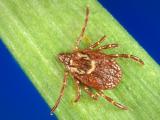Although case numbers remain low, average annual US incidence of a rare bacterial zoonotic disease rose by more than half from 2011 to 2022, according to new surveillance data from the Centers for Disease Control and Prevention (CDC).
In a report published yesterday in Morbidity and Mortality Weekly Report, CDC investigators said 2,462 tularemia cases were reported over the period, with the annual average incidence of 0.064 per 100,000 population representing a 56% increase compared with the previous surveillance period (2001 to 2010). Incidence was highest among children ages 5 to 9 years old, older men, and American Indian or Alaska Natives (AI/AN).
Tularemia cases were reported by health departments in 47 states overall, but investigators with the CDC's National Center for Emerging and Zoonotic Infectious Diseases say half of all reported cases came from four states—Arkansas (18%), Kansas (11%), Missouri (11%), and Oklahoma (10%). Roughly 205 cases were reported per year, ranging from 149 in 2012 to 314 in 2015. Most patients (78%) were reported to have symptom onset during the months of May through September.
Many potential exposures
Tularemia, also known as "rabbit fever," is a highly infectious disease caused by the bacterium Francisella tularensis, which the CDC has designated a Tier 1 Select Agent—the highest risk category—based on its potential for use as a bioweapon. Humans can become infected through tick or deer fly bites, improper handling of infected animals (such as rabbits, muskrats, prairie dogs, and other rodents), inhaling contaminated dust or aerosols, and drinking contaminated water.
The symptoms of tularemia vary based on how the pathogen enters the body. They can include skin ulcers, mouth ulcers, sore throat, and pneumonia, and are always accompanied by fever. While the infection is treatable with antibiotics and the case fatality rate is under 2%, it can be as high as 24%.
The demographic characteristics and regional distribution of US tularemia patients from 2011 to 2022 were similar to those described in the previous surveillance period. The median age of case patients was 48 years, and 63% were men. White persons accounted for most tularemia cases (84%), followed by AI/AN (9%), Hispanic or Latino (5%), Black or African American (2%), and Asian or Pacific Islander (1%) persons.
Increased reporting of probable cases might be associated with an actual increase in human infection, improved tularemia detection, or both.
Incidence among AI/AN persons (0.260 per 100,000) was approximately five times higher than among Whites.
"Many factors might contribute to the higher risk for tularemia in this population, including the concentration of Native American reservations in central states and sociocultural or occupational activities that might increase contact with infected wildlife or arthropods," the authors wrote.
Improved detection
The investigators also note that the proportion of tularemia cases identified as probable from 2011 to 2022 (60%) represents a 71% increase from 2001 to 2010. While this could be related to a 2017 change in surveillance criteria that included detection of F tularensis by polymerase chain reaction in the probable case definition, they say updated surveillance criteria doesn't fully explain the rise in tularemia incidence.
"Increased reporting of probable cases might be associated with an actual increase in human infection, improved tularemia detection, or both," they wrote.
The CDC says reducing tularemia incidence will require tailored prevention strategies that lay out the variety of potential F tularensis exposures in the environment. They also call for increased healthcare provider education on the diverse clinical manifestations of the disease and the importance of early and appropriate antibiotic treatment.
















